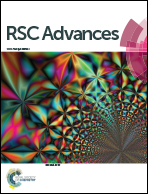Conduction mechanism model, impedance spectroscopic investigation and modulus behavior of the organic–inorganic [(C3H7)4N][SnCl5(H2O)]·2H2O compound
Abstract
In this study, the electric properties and modulus formulation of the compound [(C3H7)4N][SnCl5(H2O)]·2H2O were studied in the 200 Hz to 5 MHz frequency range and the 343–418 K temperature range. Cole–Cole (Z′′ versus Z′) plots of this compound were well fitted to an equivalent circuit formed by a parallel combination of resistance (R), fractal capacitance (CPE) and capacitance (C). Arrhenius behavior of the direct current conductivity confirmed the transitions observed in the calorimetric study. The dependence of AC conductivity on frequency was found to satisfy Jonscher's universal power law at different temperatures, σ(ω) = σdc + Aωs. The (AC) electrical conduction in this material is supported by two theoretical models of conduction that can be attributed to the non-overlapping small polaron tunneling (NSPT) model in phase I and the correlated barrier hopping (CBH) mechanism in phases (II) and (III). Moreover, study of the structure–electronic property relationship implied the dominance of proton conduction in the hydrated form of the compound (region I). Moreover, after crystal dehydration (in region II and III), the conduction was assured by the contribution of the movements of anionic and cationic parts. For the modulus formalism, the extracted activation energies from the linear fit of ln(fp) as a function of 1000/T matched well with those obtained from dc conductivity in regions (II) and (III), which confirmed the hopping mechanism in these two regions.
![Graphical abstract: Conduction mechanism model, impedance spectroscopic investigation and modulus behavior of the organic–inorganic [(C3H7)4N][SnCl5(H2O)]·2H2O compound](/en/Image/Get?imageInfo.ImageType=GA&imageInfo.ImageIdentifier.ManuscriptID=C6RA16679B&imageInfo.ImageIdentifier.Year=2016)

 Please wait while we load your content...
Please wait while we load your content...